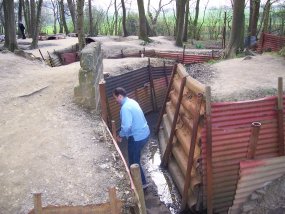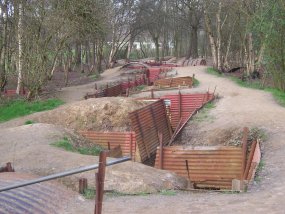
WWII: Maginot Line | Normandy | V-Weapon Sites | Arnhem
Further afield: Crete
| Home Tracing Military Ancestors Travel Advice CWGC Cemeteries Iron Harvest News Book Reviews Glossary Links Contact Me Ypres:
 
|
Core Location 9 – Sanctuary Wood
Directions – From Hooge continue down the Menin Road towards Ieper and then take the first turning on the left signposted to Sanctuary Wood Museum. You’ll drive for about 1km, passing Sanctuary Wood CWGC Cemetery on your right (the resting place of Lieutenant Gilbert Talbot – see Optional Location 1 - Talbot House, Poperinghe) before reaching the museum which is housed behind a café. Practical Information – Sanctuary Wood Museum contains the only original section of First World War trench in the Salient to survive to the present day. Indeed, along with Tyne Cot and the “In Flanders’ Field Museum” it is probably one of the most visited locations in the Salient and can get very crowded throughout the day. During the summer period it’s advisable to visit this location later in the afternoon. Further up the road is a memorial to the capture of Hill 62 by the 3rd Brigade of the 1st Canadian Division on 13th June 1916. Historical Notes – Sanctuary Wood does seem an incongruous name for any location in the Salient frontline. It was so named during First Ypres when the main fighting was three miles to the west at Gheluvelt and the wood was used as a rallying point for soldiers isolated from their units. However, by Second Ypres it was in the frontline and, along with Hooge, Mount Sorrel, Hill 62 and Hill 60 nearby, was the scene of a series of bloody battles in 1915-16 to secure the high ground on the western edge of the Salient. The most serious assault against the British positions occurred on 2nd June 1916 when, preceded by a whirlwind bombardment, the XIII Wurttemberg Corps attacked the Canadian 3rd Division based on Hill 62, Mount Sorrel and Sanctuary Wood. The Germans were confident that their artillery had smashed the Canadian trenches but, as at St Julian in April 1915, the surviving Canadians fought tenaciously to prevent a complete collapse. However, by the end of the day, all the high ground was in enemy hands and some Canadian units had taken severe casualties - 4th Canadian Mounted Rifles was reduced to just 76 unscathed men by nightfall. The loss of this high ground so close to the town could not remain uncontested and General Byng, commander of the Canadian Corps, brought up the 1st Division to counter-attack and retake the lost positions. Two hundred and eighteen artillery pieces were trained on the area, including over a hundred medium and heavy guns to support the counterattack. The British guns pounded the German line four times between 9th and 12th June – each time the Germans expected an attack. Finally, in the early hours of 13th June, amid a heavy downpour, infantry of the Canadian 3rd, 13th, 16th, and 58th Battalions surged forward. The Germans, expecting another "false-alarm", were taken completely by surprise and all the high ground was recaptured with little loss. As the British Official History added, "The first Canadian deliberately-planned attack in any force resulted in an unqualified success". Eyewitness Account – In R.C. Featherstonhaugh’s "The 13th Battalion Royal Highlanders of Canada 1914-1919" one of its officers describes Sanctuary Wood at this time as: "...a wood in name only. Such trees as stood were riven and leafless, while their fallen branches added to the maze of wire and trenches beneath. The air was heavy with the sickening odour of decay, so that the whole battered district, even by day, was a place of grisly horror and evil omen." Extract taken from Walking the Salient by Paul Reed, Leo Cooper 1999. |
|||||


